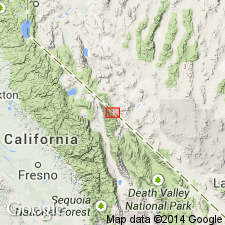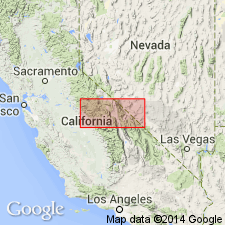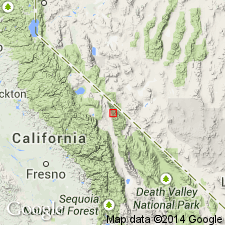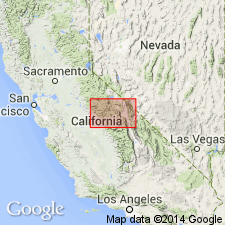
- Usage in publication:
-
- Barcroft Granodiorite
- Modifications:
-
- Original reference
- Dominant lithology:
-
- Granodiorite
- AAPG geologic province:
-
- Sierra Nevada province
Summary:
Pg. 137. Barcroft Ganodiorite. Characterized by medium-gray color due to high mafic content and to bluish-gray quartz and feldspar. In contact with younger sedimentary rocks and the younger McAfee Adamellite (new). Eastern part of unit previously called quartz diorite by Anderson (1937, GSA Bull., v. 48, no. 1, p. 74) and larger western part, which extends beyond western margin of quadrangle, formed part of Anderson's Pellisier Granite (1937, p. 8). Age is probably Jurassic or Cretaceous, based on stratigraphic relations.
Mapped in (shown on sketch map) Mount Barcroft 7.5-min quadrangle, in White Mountains, eastern CA. Part of Inyo batholith.
Source: US geologic names lexicon (USGS Bull. 1350, p. 46); GNU records (USGS DDS-6; Menlo GNULEX).

- Usage in publication:
-
- Barcroft Granodiorite
- Modifications:
-
- Areal extent
- AAPG geologic province:
-
- Sierra Nevada province
Summary:
Pg. 3. Barcroft Granodiorite mapped with Mesozoic granitic rocks. Recognized in White Mountains. Age considered Cretaceous(?).
Source: Publication; US geologic names lexicon (USGS Bull. 1350, p. 46).

- Usage in publication:
-
- Barcroft Granodiorite
- Modifications:
-
- Age modified
- AAPG geologic province:
-
- Sierra Nevada province
Summary:
Age of Barcroft Granodiorite is given as 165 to 160 Ma, Middle Jurassic. Age of Barcroft structural break across plutons is interpreted to be younger than age of Barcroft Granodiorite in contrast to previous interpretations.
Source: GNU records (USGS DDS-6; Menlo GNULEX).

- Usage in publication:
-
- Barcroft Granodiorite*
- Modifications:
-
- Age modified
- AAPG geologic province:
-
- Sierra Nevada province
Summary:
Barcroft Granodiorite (Emerson, 1966) is equivalent to quartz monzonite of Mount Barcroft (this paper) and granodiorite of Mount Barcroft (Krauskopf, 1971; Crowder and Ross, 1973; Crowder and Sheridan, 1972). Occurs in two masses separated by Cretaceous granite of McAfee Creek. Modes show considerable spread on Q-A-P diagram and extend across quartz monzonite and quartz monzodiorite fields. Age is Late Jurassic (on map) based on U-Pb age on zircon of 161 Ma (Stern and others, 1981). [Text also cites Gillespie (1979) with 165 Ma.]
Source: GNU records (USGS DDS-6; Menlo GNULEX).
For more information, please contact Nancy Stamm, Geologic Names Committee Secretary.
Asterisk (*) indicates published by U.S. Geological Survey authors.
"No current usage" (†) implies that a name has been abandoned or has fallen into disuse. Former usage and, if known, replacement name given in parentheses ( ).
Slash (/) indicates name conflicts with nomenclatural guidelines (CSN, 1933; ACSN, 1961, 1970; NACSN, 1983, 2005, 2021). May be explained within brackets ([ ]).

